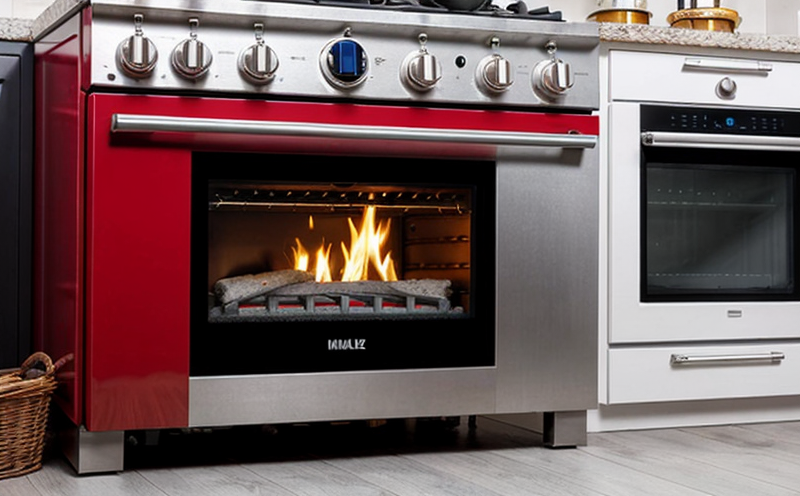Surface Flame Spread Testing of Appliance Materials
In the realm of fire safety testing, particularly within household appliances, ensuring that materials used do not contribute to the spread of flames is paramount. This is where surface flame spread testing comes into play. The objective is to evaluate how a material responds when exposed to an external heat source and flame. This test is crucial for compliance with various international standards aimed at preventing fires in domestic settings.
The test involves placing a sample of the appliance material on a standard support and subjecting it to a specified flame. The time the flame remains burning after being removed, as well as the distance it travels along the surface, are measured. These metrics help determine the relative flammability and fire resistance properties of materials used in household appliances.
For instance, testing is often conducted on components such as control panels, insulation foams, wiring coverings, and other parts that could come into contact with heat sources within an appliance. The results are used to ensure that these components meet the necessary standards for fire safety.
The test setup typically involves a specially designed furnace where the temperature and flame intensity can be controlled according to ISO 13943 or ASTM E84, among others. Specimens are cut into standard sizes and positioned vertically in the furnace. The duration of time that the flame remains burning after being removed is recorded, along with any distance it spreads across the material.
Understanding these parameters allows manufacturers to select materials that not only meet regulatory requirements but also enhance the overall safety and durability of their appliances. This testing process ensures that consumers are protected from potential fire hazards in their homes.
The importance of this test cannot be overstated, especially given recent trends towards more compact and energy-efficient appliances. As technology advances, so too do the materials used in these devices. Ensuring that these new materials meet stringent flame spread testing requirements is essential for maintaining high safety standards.
- ISO 13943: This international standard provides guidelines for conducting surface flame spread tests on building products and components to assess their fire performance.
- ASTM E84: Another widely recognized standard that specifies the procedure for measuring smoke production, flame spread, and heat release of materials exposed to a controlled fire environment.
Quality and Reliability Assurance
The quality and reliability assurance process for surface flame spread testing is robust, involving multiple steps to ensure accurate results. First, the samples must be prepared according to specific dimensions and specifications as outlined in ISO standards.
The furnace used for testing must also meet stringent criteria to ensure consistent temperature and flame conditions. This includes regular calibration checks and maintenance schedules. Once the test begins, a series of measurements are taken at precise intervals to capture accurate data on flame spread and duration.
Data analysis is another critical component of this process. Statistical methods are employed to interpret results and identify trends or anomalies. This ensures that any deviations from expected outcomes can be promptly addressed.
Finally, the test results must be compiled into a comprehensive report that includes all relevant data points and observations. These reports serve as valuable resources for quality control teams and product designers alike, providing insights into material performance and areas for improvement.
International Acceptance and Recognition
The importance of surface flame spread testing is widely recognized internationally. Compliance with relevant standards such as ISO 13943 and ASTM E84 ensures that materials used in household appliances meet the highest safety benchmarks.
Countries around the world adopt these standards to protect consumers from potential fire risks. International accreditation bodies like UL (Underwriters Laboratories) and IAPMO (International Association of Plumbing & Mechanical Officials) often reference these tests as part of their certification processes for appliances.
Recognition extends beyond national borders, with many global manufacturers seeking compliance with international standards to ensure their products are accepted in diverse markets. This not only enhances marketability but also reinforces the brand's commitment to safety and quality.
Environmental and Sustainability Contributions
In addition to enhancing fire safety, surface flame spread testing contributes positively to environmental sustainability efforts. By ensuring that materials used in household appliances are inherently less flammable or more resistant to spreading flames, we reduce the risk of fires which can lead to increased energy consumption for firefighting operations.
Furthermore, using tested and approved materials helps manufacturers design products with reduced fire hazards, leading to safer homes. This has a cascading effect on reducing waste associated with appliance replacements due to fire damage, thus promoting sustainable resource management practices.
The testing process also encourages innovation in material science, driving the development of new compounds that are both safe and environmentally friendly. These advancements contribute significantly to global sustainability goals by fostering safer and more resilient products for all users.





